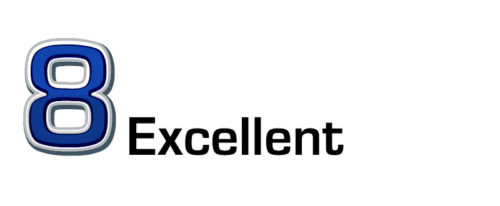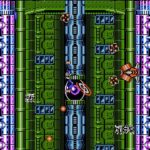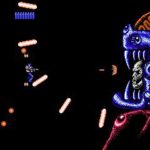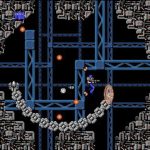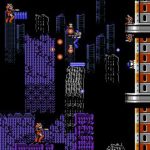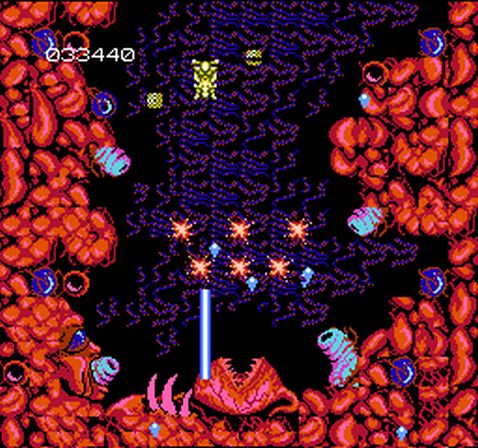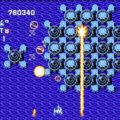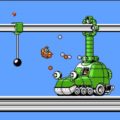Developer: Natsume Publisher: Natsume Release: 06/91 Genre: Shooter
I’ve seen my share of ridiculous video game titles but this one is probably the most tragic. Although S.C.A.T. is an acronym and more than likely flew over the heads of 80s youth someone had to have known what it implies. The name is even more tragic when you consider its Japanese title was more than fine, Final Mission. Regardless of the name this is an excellent shooter for the system and in my opinion one of its best. Natsume delivers another great NES game to sit alongside their numerous other classics.
In terms of structure this is the closest the NES would ever get to Capcom’s Forgotten Worlds. Both games are similar to a creepy degree: both are two-player coop games starring flying protagonists among alien environments. Where FW starred two beefy men S.C.A.T. stars Arnold and Sigourney and it is no coincidence that they look like certain actors who share the same first names. I remember loving the Genesis version of Forgotten Worlds and being jealous that I had nothing like it for my NES. That feeling magnified when even the Master System received a version of the game. Luckily Natsume came through and delivered a great take on that arcade classic.
The number of weapons is relatively small although they are no less effective. There are three primary weapons, wave beam, laser, and bomb. The wave and laser are more or less self-explanatory. Bomb is the most powerful as it detonates on impact and continues to damage anything in its radius although it is slow. More importantly though your hero is equipped with two satellites. These “options” provide additional fire and can either lock in place or circle around you. Maximizing their usage is crucial to the game as the levels scroll in every direction and your primary fire is limited to directly in front of you.
Despite consisting of five levels S.C.A.T. covers a lot of ground. The action begins in the ruins of New York City before proceeding underground to enter the Astrotube connecting the alien base to Earth. Next is a vertical ascent up the passage to assault the aliens directly. Stage four is a pretty good recreation of the assault on the capital ship in R-Type. The final level pulls out all the stops and is the longest, filled with all manner of laser traps and deliberate enemy placement. The horizontal and vertical scrolling action provides plenty of opportunity to use your options two modes and if you hope to see this to the end you’ll need it.
Overall I would say this presents a meaty challenge. You have a sizable life bar however that can drain pretty quickly as enemies approach from all sides. Your weapons aren’t particularly strong so using your satellites becomes absolutely mandatory to survival as they cover your blind spots. The boss battles are actually the easiest parts of the game; it’s actually getting there that is the hassle. Health power-ups are rare and the game does not refill your life after every level. With a single life and only six continues I can see many having to whittle away at this for a few hours which is surprising as the game is pretty short.
The only major flaw in S.C.A.T. (that sounds funny) is that it could stand to use a few more levels. Each of its five levels is long and in some cases like stage three’s orbital elevator tend to drag on. Shorter but more varied stages would have gone a long way toward making this feel really special. As it is there is just enough time to adjust to the game’s mechanics before it’s all over. Ah well, what could have been.
I mentioned the original Japanese title for the game, Final Mission. That was not the only change during localization. Back in the day it was almost customary that the Japanese release of a game was superior to its American counterpart yet here we have the opposite. Taking a page out of Konami’s handbook the protagonists were cast as famous movie stars, in this case Arnold Schwarzenegger and Sigourney Weaver. The game was made easier by doubling your life bar. The biggest change though is giving full control over your satellites rather than the Gradius style behavior they originally exhibited. That is such a critical element to the game that I can’t believe it wasn’t there originally. Lastly a map screen was added although it’s a superfluous addition. Improvements like this were rare so it is nice to see we got the better game, fetish title aside.
S.C.A.T. sports a greater amount of detail in its environments than most Nintendo titles. The one caveat is that it also suffers from some of the worst flicker and slowdown on the system. At its worst moments numerous sprites straight up disappear and the game slows to a crawl. These moments are not too frequent until the game’s back half and unfortunately are very jarring. It is not game breaking but still notable enough to point out.
In Closing
If S.C.A.T. had two or three more levels it could have entered the conversation for the best NES shooter. It is still great but all too brief and will leave you wanting more.
